
The HCM City People’s Committee’s draft report on the socio-economic situation showed that 2,536 businesses were established in the city in January with a total registered capital of VND18 trillion, a decrease of 7.07 percent in quantity and 38 percent in capital compared with the same period last year.
As many as 10,255 enterprises suspended operations, an increase of 21.05 percent, and the number of businesses resuming operations decreased by 31.82 percent (3,235 enterprises).
Meanwhile, the HCM City Statistics Office reported that the IIP in Jan dropped by 21.36 percent compared with the previous month and 14.96 percent compared with the same period last year. The inventory index rose by 6.6 percent.
As the Tet holiday was in Jan 2023, the production output in the first month of the year was lower than December 2022 and Jan 2022. This explained the IIP and import-export turnover decreases.
In addition, enterprises are not as busy now because of few orders from foreign partners. Analysts warn that the situation may last until mid-year.
The decrease in both the number of newly set up businesses and registered capital portend difficulties for economic recovery in 2023.
According to General Statistics Office (GSO), goods export turnover in January 2023 for the whole country was estimated at $25.08 billion, down by 13.6 percent compared with the previous month and 21.3 percent compared with the same period in 2022.
In Jan 2023, VNDirect cited Fitch’s report as saying that the consumer spending growth rate was 2.5 percent in 2022, but is predicted to fall to 0.9 percent in 2023 because of global recession.
The US FED’s move of raising the interest rate will affect employment and spending in 2023 as the US, together with the EU, are Vietnam’s major trade partners. China’s reopening will not offset the weak demand from the US and EU.
Because of the sharper-than-expected falls in the number of new orders, VNDirect predicts that export growth in 2023 will be just 5 percent (the growth rate was 9.5 percent in 2022).
Problems to be solved
Pham Van Viet, deputy chair of the Handicraft and Wood Industry Association of HCM City (Hawa), predicted that the textile and garment industry would continue to face difficulties in Q1 and 2 before it gradually recovers in Q3. The EU market will not be busy in the first two quarters, while the US market may see improvement in Q2.
As for Japan, South Korea and China, and other ASEAN countries, Vietnamese enterprises can export products to these markets but at prices lower than exports to the US and EU.
Viet said in the long term, banks need to set reasonable lending policies and fund enterprises’ purchases of high technologies, or they will lag behind and not be able to compete with rivals in the world market.
Meet More Coffee CEO Nguyen Ngoc Luan noted that Vietnam is slow in setting up policies which are behind what is happening in reality. Meanwhile, high credit interest rates and inflation in importing markets will affect Vietnamese exports.
In the retail industry, Furusawa Yasuyuki, CEO of Aeon Vietnam, said the number of shoppers has been increasing, but shopping frequency is on the decrease.
Aeon says that Vietnam is its second most important market, but the Japanese retailer is facing difficulties developing shopping centers in the suburbs because of poor infrastructure conditions. Also, the capability of suppliers of domestic goods is uneven.
Su Ngoc Khuong from Savills Vietnam said images of workers returning early to hometowns to celebrate Tet holiday was proof of the lack of orders.
Khuong commented that with a monthly income of VND5-7 million, workers lack savings after they pay for rent and daily expenses.
“Vietnam needs a longer-term vision for economic development in a fast-changing world,” he said.
Tran Chung